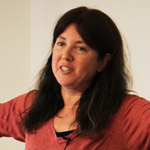Welcome to the Convergent Science Network Podcast!
During the BCBT Summerschools (2010, 2011, 2012, 2013, 2014) hosting professors Paul Verschure and Tony Prescott interviewed several speakers after their lectures. Interviews are also conducted on other occasions with various scientist in converging fields.
About the hosts: Paul Verschure is ICREA Professor at SPECS, Universitat Pompeu Fabra, Barcelona; Tony Prescott is Professor of Cognitive Neuroscience, University of Sheffield.
The Convergent Science Network of biomimetic and biohybrid systems (CSN, www.csnetwork.eu) is a coordination action for the development of future real-world technologies. CSN is supported through the Future and Emerging Technology programs (FET) of the Information and Communication Technologies (ICT) work programme of Framework Programme 7 of the European Commission.
Audio (post-)production: Sytse Wierenga. Podcast site: Alberto Betella.
Thoughts, discussions, and achievements in neurobiology, biomimetic and biohybrid systems
We can learn a lot from brains and bodies when making machines and robots. But reversely, building complex machine systems can also give ideas about how brains and bodies have implemented their functioning over the evolution of ages. This podcast discusses various themes and aspects in-between robotics, neuroscience, cognitive science, artificial intelligence, biology, and technology.
Interview with Mehrav Ahissar
03-04-2018

This post-lecture interview was conducted during the BCBT Summerschool held at the Universitat Pompeu Fabra, Barcelona, september 2010.
With respect to perception, Merav Ahissar (Hebrew University, Israel) wishes to distinguish between the hierarchical direction of signal processing, and the hierarchical direction of explicit perception. In her view, the way we recognize features, items, objects, persons in our environments could be prone to more top down processing than perhaps classically thought. With Paul Verschure she discusses her ideas of a two-way system, in which the processing of a quick, bottom-up estimate of environmental features and global scheme recognition combines with the activation of scheme specific 'pointers', that offer and induce detailed information stemming from earlier encounters with the world, or training. With respect to how we learn to recognize our environments and its meaningful elements, it is yet unclear how to disambiguate between the strengthening of bottom-up feature recognitions, and top-down pointer generation. With Paul Verschure, Merav Ahissar discusses how to assess such questions experimentally, in both the visual and auditory domain of perception. A recurrent challenge lies in the distinction between recognition at lower, and higher levels: where and how do the top-down and bottom-up directions meet in the recognition processing of seen scenes, objects and persons, as well as of heard tones, words, and semantic meaning.
About the lecturer
Mehrav Ahissar is Professor at the Department of Psychology of the Hebrew University in Jerusalem. Her research focuses on the perceptual basis of cognitive abilities, auditory perceptual learning, and the perceptual basis of reading and learning disabilities.
Categories | | Neuroscience | Perception
Filetype: MP3 - Size: 66.12MB - Duration: 57:39 m (160 kbps 44100 Hz)
Tweet


